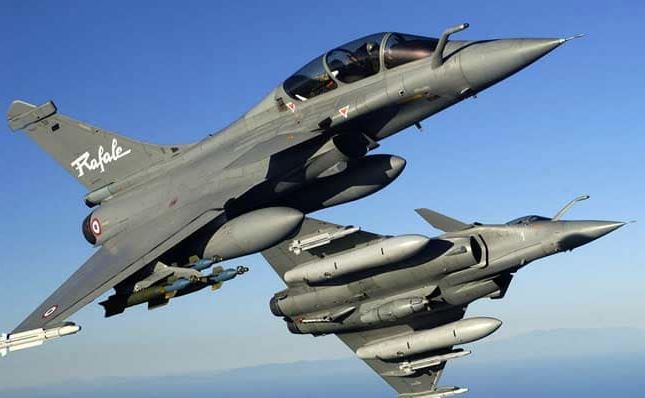Goa is abuzz with excitement as vintage bike and car owners, users, collectors and fans are decking […]

RAFALE AUDIO TAPE SHAKES BJP!
Jan 05- Jan 11 2019, Stray Thoughts January 5, 2019BLACKMAIL: In an audio clip circulated in Parliament by Rahul Gandhi it is alleged that Manohar Parrikar told the Goa Cabinet that all the secrets of Rafale aircraft deal were in his bed room and the Centre could not sack him. The clip was allegedly leaked by Vishwajit Rane who has denied this
BY RAJAN NARAYAN
And a few stray thoughts for yet another Saturday. For a Saturday following the week when everyone was agog over a recording allegedly of Parrikar saying he had the Rafale files in his bedroom. For a Saturday following the week when Chief Minister Manohar Parrikar seems determined to prove doomsayers wrong. For a Saturday following the week when it was a relatively poor New Year for those involved in the travel and trade industry. For a Saturday following the week when Goa continued to lag very far behind in eliminating open defecation. For a Saturday following the week when even three months after the formalin fish scare came up, we are not aware of whether the fish available in the market is safe to eat. For a Saturday following the week when, despite the reductions in GST rates, there continued to be resentment against the GST.
RAFALE TAPE
And a few stray thoughts on the bedlam in the Lok Sabha over a leaked audio tape allegedly carrying the voice of Manohar Parrikar telling his Cabinet colleagues that all the Rafale deal files are in his bedroom. The minister who is reported to have leaked the audio is suspected to be Vishwajit Rane. The implication is that Parrikar is blackmailing Narendra Modi and Amit Shah to ensure that they allow him to remain as chief minister despite the state of his health.
The audio tape has some credibility as at one stage there were strong rumours that Amit Shah had decided to replace Manohar Parrikar as chief minister. Parrikar himself was willing to step down provided Promod Sawant was elected as the leader of the Legislative Party. This was not acceptable so Parrikar decided to stick to his kodel.
As the alliance partners were also not willing to accept any other BJP leader as chief minister, Amit Shah was forced to drop the idea of replacing Parrikar as chief minister. This is contrary to the impression that Parrikar was being forced to continue as chief minister as the Goa government could collapse if he was removed.
Although Sudin Dhavalikar wanted to become chief minister with the support of Nitin Gadkari, this was opposed by Vijai Sardesai of the Goa Forward, who has the support of six MLAs.
If the audio tape is true it would seem that it is Parrikar who is insisting on sticking to the chair like Fevicol.
Both Parrikar and Vishwajit have denied the contents of the audio. Parrikar has been claiming that it is fabricated while Rane has demanded a CBI investigation.
Finance Minister Arun Jaitley has sarcastically commented that the Congress is headed by a leader (Rahul Gandhi) who has no understanding of combat aircraft. He seems to have forgotten that Rahul’s father, Rajiv Gandhi, was a pilot with Indian Airlines. Meanwhile the Shiv Sena and other Opposition parties have joined the demand for a probe into the Rafale deal though the Supreme Court has given a clean chit to the government.
The Congress has been insisting that the BJP lied to the Supreme Court while claiming that a report by the Vigilance Commission and the Parliamentary committee has been submitted even though the Rafale deal was not referred to this committee.
The biggest reason for suspicion is that Parrikar, the then defense minister, was not in France with the prime minister when the Rafale deal between then French President Francois Hollande and Narendra Modi was signed.
Parrikar, unlike other BJP ministers and officials, has not made a single comment on the Rafale deal. Most of the time of Parliament on Wednesday and over 50% of the space in daily newspapers was devoted to the alleged audio leak.
BACK TO WORK?
And a few stray thoughts on Chief Minister Manohar Parrikar returning to his office in the Secretariat after a gap of three months. It would appear that Parrikar wants to prove that while he is tired, he has no intension of retiring. Or maybe it is the arrival of Satish Dhond as general secretary of the BJP which has hastened the arrival of the Chief Minister to the Secretariat.
The return of Satish Dhond, who was general secretary earlier was a signal to Parrikar to either resign or resume office. Parrikar is well aware that Satish Dhond is an extremely tough character and his chamchas like Vinay Tendulkar and Sadanand Tanawade cannot have their way with him.
Dhond proved his rough tactics the day after he arrived to Goa when he led a yatra or jatra to the Congress office protesting against the comments of Rahul Gandhi against the Rafale deals. The fact that it was a lady, Pratima Coutino, the leader of the Mahila Congress, who was resisting him, did not bother Dhond. Clearly Dhond has instructions from the RSS in Nagpur to straighten out affairs in the State before the Parliamentary elections.
The RSS is most concerned about not just the split by Subhash Velingkar from the RSS, but his decision to form a separate political party and contest the elections. Velingkar has considerable support among the RSS cadre and he will cut into the BJP vote. An even greater fear is that Velingkar may join hands with the MGP which will further undermine the BJP.
There is very little support for the BJP any longer in Goa as was proved in the last Assembly election in 2017, when the party got only 13 seats. The alliance partners with whom the BJP formed an alliance to steal the government from the Congress are clear that their support was to Parrikar and not to BJP. So Dhond or Parrikar have to make sure that promises made are fulfilled, so that the BJP wins the two parliamentary seats in Goa.
In the light of the disenchantment from the minority community, Parrikar has the task of again getting Catholics to support the BJP. Many Catholic leaders, particularly Micheal Lobo and Nilesh Cabral, have come out against the BJP. The most vociferous of the critics of Manohar Parrikar is former Deputy CM Francis D’Souza. Senior BJP leaders like Parsekar and Arlekar are also angry about the BJP not only allowing Subhash Shirodkar and Dayanand Sopte into the party, but immediately giving them offices for profit.
Chief Minister Parrikar’s main concern seems to be the progress of the new Mandovi Bridge and expediting recruitment. There are more than 5,000 vacancies pending which have not been filled. The resumption of mining is also a top priority with the BJP.
Unfortunately the photographs of the chief minister, particularly the one in the Navhind Times with Satish Dhond, do not inspire confidence. It gives the impression that it is Dhond that is giving orders. Besides, it is clear that Parrikar, with a tube through his nose and his inability to walk without support, is not fit or able to govern the state with 30 portfolios in his charge. The state cannot be run by spending one hour as a token gesture in the Secretariat.
BURE NEW YEAR
And a few stray thoughts on a bure New Year for the business community in Goa.
The president of TTAG, Savio Messias, has admitted that there has been a very sharp drop in charters from Russia and England. A lot of the Russian charters used to come from Ukraine which is again at war with Russia. Ukraine is one of the countries which were part of the Soviet Union until its dissolution. Since 2014 ties between Ukraine and Russia have been more strained than ever, with Russia, headed by Russian President Putin, annexing the Crimean Peninsula from Ukraine in early 2014. The annexation was accompanied by military intervention by Russia in Crimea.
Due to the steep increase in fuel prices, many people in UK and Russia prefer closer and cheaper destinations. India and Goa have been out-priced as it is far more expensive to have a holiday in India than in Malaysia or Thailand. During the peak of peak tourist season you can get the 5-star hotel room for about `8000 and travel to/fro and within Goa is expensive.
Even domestic tourists have other options now. During the peak of peak tourist season, newspapers carried ads offering packages to Thailand and Malaysia for `18,000, which is equivalent to the fare from Goa to Bombay on January 2nd, the day after New Year.
I personally tend to believe that it is GST which is made visiting Goa more expensive. This is because the GST on a 5-star room is 28% which is the highest slab. In addition if you have lunch or dinner the GST slab is 18%. If you have a drink, even if it is a beer, the VAT is 22%. So much so, 30% or more of the bill, even if you eat a simple fish thali goes towards GST.
There are of course other factors like the erosion of beaches and destruction of sand dunes. Unlike in the past, Goa is also literally drowning in garbage. Even in the pictures published of New Year’s Eve celebrations you can see domestic tourists with bottles in their hands attempting to swim at 2 am in the morning.
Compounding the problem are the state of the roads. This year I decided to spend New Year’s Eve at the Taj Exotica which I have not visited for a long time. While going from Panjim I had to go through Ponda because of a three hour traffic jam between Siridao and Verna. Though it took me 4 hours the drive was much smoother as the roads are much better. My return trip through Margao and Panjim took an equal amount of time and made me feel ill because of the terrible condition of the roads near the Zuari bridge and the New Mandovi bridge.
The worst affected by the lack of tourists are shack owners and hotels. During Christmas, the occupancy in most hotels was just 60% or less and shacks were half empty. Goa will have to pull up its socks if it wants to continue to attract tourists.
STILL NOT OD FREE
And a few stray thoughts on Goa continuing to lag behind in the national campaign to make Goa open defecation (OD) free — which in simple terms means people are still shitting out in the open because they don’t have a toilet
When the Central Ministry of Drinking Water & Sanitation conducted a survey it was shocked as the impression was that a modern state like Goa would be completely OD free. Open defecation is a legacy of Portuguese colonial rule. Unlike in British India, the Portuguese did not build any underground sewerage systems. Particularly in the villages in Goa it was the pig-type toilet which was used. The pigs took care of whatever fell from the toilet. As the singer Remo commented, the people living in the house in turn ate the pig which had grown fat on their waste. When finally the pig-type toilets were abandoned by 2000 they were replaced by soak pits.
This meant that a concrete or sometimes even mud chamber was built below the ground with the pipe connecting the toilet to the pit. The soak pits had to be cleaned regularly by manual labour. Even now large parts of Goa, including cities, do not have an underground sewage system. Only Panjim city proper, up to Miramar, has an underground sewage system.
An attempt was made to build the sewage system from Miramar to Dona Paula but was done so badly that sea water came into the sewage tunnel. In Margao a sewage system was set up by spending a lot of money. You can take a horse to water but you cannot make it drink. To recover the cost of building the sewage system, houses were charged to connect their toilets and sumps to the sewage system. Unfortunately most people are unwilling to pay for the connections.
In villages there are still no sewage systems and most houses depend on soak pits. Unfortunately houses that have been built near industrial estates for migrant labour do not even have soak pits.
The worst taluka in the State when it comes to failure to eliminate OD is Canacona. Less than 50% of the homes have a toilet and many of the residents still do the job outside on the roads or in the fields.
It is a disgrace that Goa, considered among the top tourism destinations in the world, should still have the practice for shitting in the open.
FISHY QUESTIONS
And the few stray thoughts on confusion over the quality of fish even four months after it is discovered that fish imported to Goa was contaminated with formalin.
As you may recall, there were some reports of food poisoning in fish from other states like Orissa and Kerala, because of which, a food inspector of the Goa Food & Drugs Administration, Ida Fernandes, decided to check samples of sea food imported into Goa. She discovered that they had high levels of formalin. What she did not know was that the largest exporter and indeed the president of the Fish Importers Association, Ibrahim Shaikh, was a close friend of TCP Minister Vijai Sardesai.
Within a few hours the FDA changed the report and claimed that small quantities or formalin were naturally present in fish. This was denied very strongly by experts from the NIO and other research organisations. Even the FDA in the US and the British health authorities confirmed that formalin or formaldehyde did not occur naturally in fish. On the contrary the presence of formalin could cause cancer. The best known use of formalin is in preservation of dead bodies in the morgue.
The matter is before the Goa Bench of the Bombay High Court which has asked the government to set up an expert panel on whether formalin was naturally present in fish. The court is also asking the expert panel to find out the maximum permissible safe limits of formalin.
No answers are yet being provided officially to the court as the government keeps asking for more time. There has been some relaxation in the import of fish due to protests from neighbouring areas in Maharashtra and Karnataka. It has now been decided that fish coming from within a distance of 60 km in small vehicles like Boleros and mini trucks will be permitted provided they have licenses.
What is strange is that while there is so much concern about contamination is fish, nobody seems to be worried about pork which is eaten in much larger quantities than fish. Most of the pork in Goa feed on toilet waste, garbage and leftovers. The result is there are very often tape worms in the pork. If you eat a sausage pao the risk that you might develop encephalitis is very strong. This is a disease which leads to epileptic fits. Chicken which is used as an alternative of fish could be equally dangerous because steroids are pumped into chicken to make them fatter just as chemicals are used to ripen bananas and manages.
Unfortunately there has been very little action taken by the FDA to promote production of farmed fish.
GST STILL TROUBLE
And a last stray thought on GST having done more harm than good.
In the first place GST has increased the prices of most commodities in the market, whether it is salt or steel. Admittedly, even before GST, there were sales tax and excise duty. But people would escape without paying sales tax or excise. Before GST when you bought any commodity you may not have been given bills and receipts unless you asked for them. This is not possible now as all traders and manufacturers have to submit returns every month.
In theory it is good both for the trader and the manufacturer that the manufacturer gets input credit for expenditure on raw materials. But all the taxes which were levied at various level are now done only at the retail level or point of sale.
Unfortunately many small traders are not very literate, and find it difficult to file GST returns particularly they are dealing with a large range of items. Unlike in other countries there is no single GST but five slabs of GST. So traders have to file separate returns for soft drinks, soaps, and various items, depending on which slab they fall under. If they don’t submit their GST return, they have to pay a fine.
It is very good system that does not work in India where small traders are not used to paperwork or digital filing of returns.















